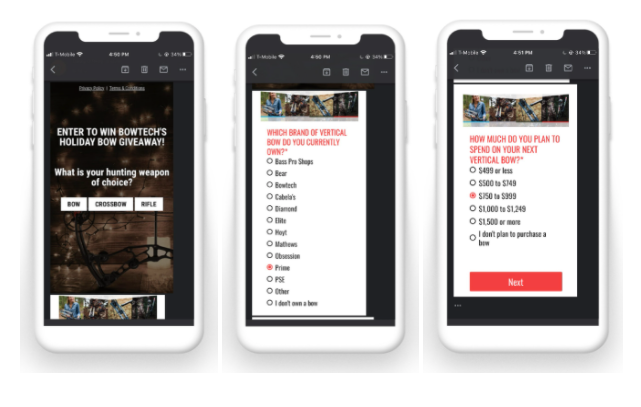Pure Archery Group gathers behavioural data at scale to deliver truly-personalised email and SMS offers.
Summary: With a 73 per cent open rate, Pure Archery Group is seeing astounding engagement with their emails. Their strategic turn to using a zero-party data strategy steeped in personalised messaging has allowed them to reduce overall annual marketing spend by $1.2 million.
The outdoor sports and recreation vertical is an ultra-competitive space. Leading brands typically spend millions on “feature wars” to differentiate their products and services from their rivals. However, fundamentally it’s a vertical hallmarked with brands using similar tactics and ad formats on the same media properties, as well as similar influencer marketing strategies, with the winners traditionally being those with the largest budgets.
Pure Archery Group (PAG) decided that rather than try to outspend their competitors with product-focused ads, they would focus their advertising budgets and labour resources on connecting directly with consumers to collect zero-party data; this included gathering data on their own customers, along with loyal customers of their competitors. Through a value-exchange sweepstakes, PAG was able to collect hundreds of thousands of unique data points from 10s of thousands of consumers to deliver truly-personalised content and offers.
The results so far include an average 63 per cent email open rate with 11 per cent average click rate. Read on to see more metrics proving this innovative approach is driving sales and an increase in market share.
Campaign objectives
To support its recent flagship product launches, PAG is looking to collect vast amounts of zero-party data to understand the psychographic needs of its existing customers as well as bring new contacts to their database.
- Grow the database with new contacts for future marketing initiatives.
- Enrich audiences with updated behavioural and psychographic data points.
- Segment the acquired audience by key psychographic insights, and inform both messaging and remarketing channels to deliver hyper-personalised and relevant content and offers.
- Use the preference insights and purchase motivations collected to personalise each customer’s experience with PAG — marketing content and offers.
Collect zero-party data at scale: Cheetah Experiences
PAG deployed several Cheetah Experiences-powered sweepstakes, and collected essential PII data like name, postcode, age, and email address, but this was supplemented by an additional seven psychographic data points on each entrant to the sweepstakes.
Actionable data like: product type of choice, the feature most important to their purchasing decision, whether they have purchased from a rival brand (so they can market to their competitors’ customers), budget size, and when they’re next looking to upgrade their kit.
Digital consumers are more scrupulous than ever when it comes to handing over their personal details and preference data, but with the rather enticing value exchange of a prize bow up-for-grabs, as well as a personalised discount for taking part, PAG’s target demographic was activated to take part in the experience.
As with all Cheetah Experiences, this campaign will live in the PAG’s marketing team experience library where it can be rapidly cloned, re-used, and configured for future similar initiatives, saving time and energy for their “always-on” engagement strategy.
Turning insights to action: personalised email + SMS offer nurture campaign
Instantly upon entry, PAG used the data collected to deploy hyper-personalised emails that elicited action. They used dynamic content, delivering over 50 potential email variations using the entrant’s name in the subject line, a personalised discount offer based on their answers, as well as the specific feature they had highlighted as most important to them.

The email went as far as to highlight the entrants budget size, complemented with suggested products and images that matched said budget size, and their preferred product (whether a bow, crossbow, or rifle).With 10s of thousands of consumers engaged in the campaign thus far, this next-gen personalisation strategy is delivering up to 71 per cent open rates (63 per cent avg), and revenue-based calls-to-action garner up to 28 per cent click rates (11 per cent avg). They’ve also identified an average 52 per cent open rate from contacts known to own a competitor’s product! Incredibly, product registration data shows that more customers are converting from competitors than ever before, proving the strategy is increasing market share, another key goal.
This email is not the denouement of PAG’s customer engagement strategy, but the beginning of a nurture campaign that will continue to collect additional net-new contacts, more zero-party psychological data points, allowing them to deliver ever-more personalised content and offers across a number of channels, including email, SMS, and even back on paid media platforms.
This is far more than an inconspicuous or throwaway marketing campaign but rather an “always-on” infusion of strategic insights data to help PAG map their 2021 marketing and advertising positions.
Results

Most brands tend to use similar strategies to their competitors, vying for incremental wins and losses over time. But using the same tactics as your competitors is a zero-sum game. PAG leveled-up by changing the entire playing field — they are innovating on how they spend their marketing and advertising resources. And by focusing on engaging their total addressable market directly, have created a scalable one-to-one, personalised communication channel that’s driving sales, including converting competitors’ customers into their own. By leveraging a strategy rooted in zero-party data and true personalisation, PAG have enjoyed the following campaign results:
- Upwards of 73 per cent open rates, 28 per cent click rates in email channel.
- Fifty-two per cent open rates with competitors’ customers in email channel.
- Increase in product registrations showing lift in market share.
- Garnered over 500k individual zero-party data points in three weeks.
- Overall $1.2M reduction in annual marketing spend annually.


